Rank Species | Genus Filipendula Higher classification Filipendula | |
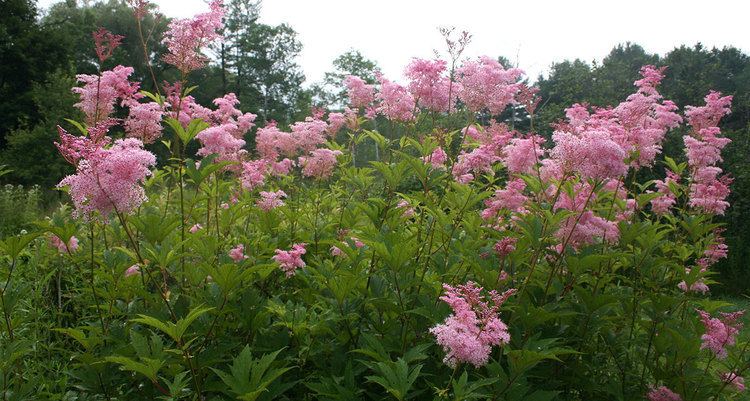 | ||
Similar Filipendula, Filipendula vulgaris, Veronicastrum virginicum, Meadowsweet, Rosaceae | ||
Filipendula rubra venusta
Filipendula rubra, also known as Queen-of-the-prairie, is a species of flowering plant in the family Rosaceae native to shady and moist habitats throughout northeastern and central United States. The plant can grow in either sunlight of part shady regions. The plant can grow in the shade if the soil is not always kept moist, the shade helps keep the soil from drying out from direct sunlight which causes a quicker evaporation of the water present in the soil. Filipendula Rubra grows tall and firm, this plant produces blooms that are tiny and pink above its ferny, pointy leaves.
Contents
- Filipendula rubra venusta
- Occurrence
- Etymology
- Characteristics
- Pollination
- Endangerment
- Causes for endangerment
- Uses
- Related species
- References
Of the numerous garden cultivars, 'Venusta' has gained the Royal Horticultural Society's Award of Garden Merit.
Occurrence
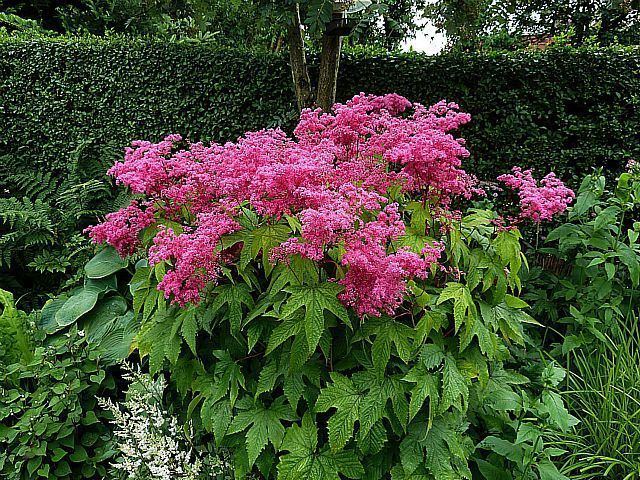
The species is native from Pennsylvania westward to Illinois, and north of Georgia. However, F. rubra is fairly successful as an alien species in places such as Massachusetts, where it was first recorded in 1875 and is still found. In many places where it is native, such as Indiana, and places where it is alien as well, F. rubra is a threatened species. The typical habitat F. rubra is wetland plant communities, particularly calcareous fens, although it is occasionally found in spring seeps and wet prairies. Populations are generally small and widely separated from one another as a result of the rarity and smallness of calcareous fens.
Etymology
Filipendula: filum is Latin for "thread" and pendulus is Latin for "hanging," Rubra is Latin for red.
Characteristics
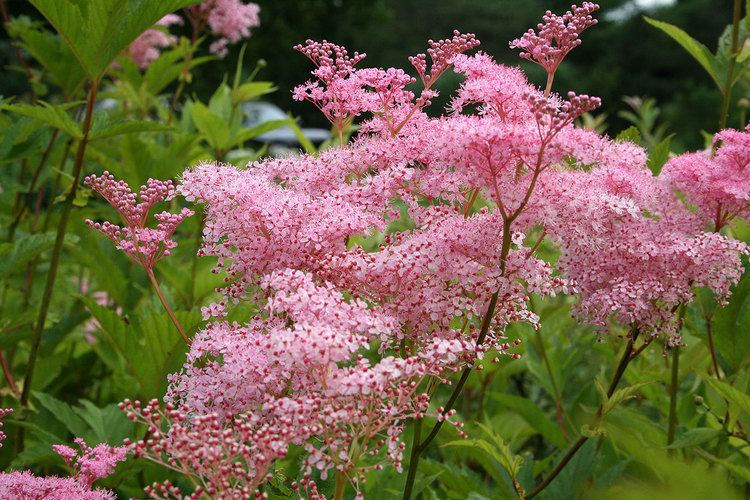
The plant is a spreading herbaceous perennial growing to 1.8–2.5 m (5 ft 11 in–8 ft 2 in) tall by 1.2 m (3 ft 11 in) wide. With large lobed leaves and branching red stems, it produces corymbs of deep pink or peach, sweet fragrant flowers in the summer. Inflorescences of F. rubra are panicles possessing 200-1,000 small pink-petaled flowers on 1-2m stems can have somewhere to 5,000 seeds. The numerous stamens give the flower a fuzzy appearance. Each flower has carpels that are free from one another, while also having five to 15 pistils. However, these seeds are small due to the large size of its clones yet when seeds are produced seedlings may fail to establish in large numbers. The plant grows in an aggressive manner with its creeping roots. The foliage texture of the plant is coarse and the color ranges from a medium to dark green.
Pollination
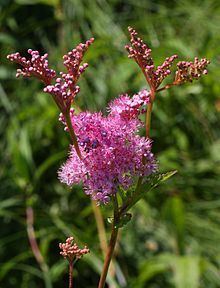
Filipendula rubra is known for its air-borne pollen, however pollination is only effective (can create a seed) when pollen is transferred to a different plant, due to the fact that F. rubra is self-incompatible. The vast majority of pollen will be derived from inflorescences within the same clone and thus incompatible. Pollination is given help due to insects spreading pollen such as the "sweat bee". Yet when given the choice, the leaf beetle Galerucella calmariensis will not feed or lay eggs on F. rubra.
Endangerment
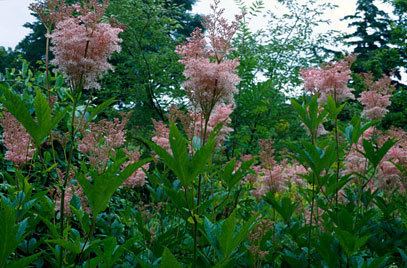
Filipendula rubra is considered an endangered species by the USDA Natural Resources Conservation Service in Illinois, Maryland, New Jersey, North Carolina and it is considered threatened in Iowa and Michigan.
Causes for endangerment
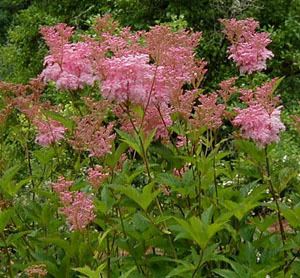
Although Filipendula rubra is considered an endangered species by the USDA in several of the states that it is native to, it is not caused by animals who eat the plant, or any diseases that may infect a plant. Rather, the F.rubra is considered endangered/threatened because of its trouble pollinating. The process the plant has to go through in order to pollinate is difficult than that of regular plants due to its inability to fertilize itself (explained further in the section above about pollination). F. rubra is further endangered by habitat loss throughout much of its native distribution.
Uses
Native Americans have used the root of F. rubra in traditional medicine for treating heart problems and as an aphrodisiac. The root has a high tannin content, making it useful as an astringent for treating diarrhea, dysentery, and bleeding.
The plant is used in gardens for the aesthetically pleasing and fragrant flowers which smell like lilac. A good number of both native and conventional nurseries sell some, yet it is still an uncommon plant in most American gardens and landscapes. 'Venusta' is the most common cultivar that bears a good bright rose-pink color. Its flowers are a good source of food for pollinating insects. It grows in full sun or part-shade and needs moist to draining wet soil; it suffers from drought. It sends up its sort of maple-like foliage early in spring. It spreads by rhizomes, underground stems, so it becomes a spreading clump that eventually becomes a mass. It is easy to dig up and reset like many perennials when it gets too big and crowded or spreads to much. It does self-sow some to a lot in gardens. If it starts to look poorly from drought, one can easily prune it down and it will grow back some to look better.
Related species
Siberian meadowsweet (Filipendula palmata): Grows to be up to 4 feet tall with medium-green palmate leaves with furry white undersides. The flowers it blooms range from a pale to deep pink color and are in clusters on sturdy stems. It is native to Russia, China, and Japan.
Japanese meadowsweet (Filipendula purpurea): Also grows up to a height of 4 feet tall with medium-green pointed, leaves and tall purple-red flower stems with deep pink almost red blooms. Native to Japan.
Queen of the meadow, meadowsweet (Filipendula ulmaria) grows the shortest of the 3 related species up to 2 to 3 feet tall with pointed, medium-green leaves, it grows a branched flower stem with dense clusters of creamy white blooms. Native to Europe, Western Asia.
